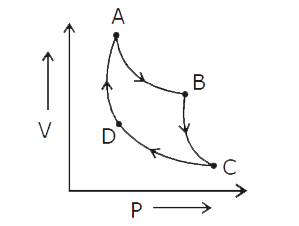The value of CP−Cv=1.00R for a gas in state A and CP−Cv=1.06R in another state. If PA and PB denote the pressure and TA and TB denote the temperature in the two states, then
A
PA=PB,TA>TB
B
PA<PB,TA=TB
C
PA<PB,TA>TB
D
PA=PB,TA<TB
Video Solution
Text Solution
The correct Answer is:C
c. For state A,CP−Cv=R, i.e., the gas behaves as an ideal gas
For state B,CP−CV=1.06R(≠R), i.e., the gas does not behave like an ideal gas.
We know that at high temperature and at low pressure, nature of gas may be ideal.
So we can say that PA<PB and TA>TB,
|
Topper's Solved these Questions
- KINETIC THEORY OF GASES AND FIRST LAW OF THERMODYNAMICSBook:CENGAGE PHYSICSChapter:KINETIC THEORY OF GASES AND FIRST LAW OF THERMODYNAMICSExercise:Multiple Corrects
Explore 29 Videos
- KINETIC THEORY OF GASES AND FIRST LAW OF THERMODYNAMICSBook:CENGAGE PHYSICSChapter:KINETIC THEORY OF GASES AND FIRST LAW OF THERMODYNAMICSExercise:Assertion-Reasoning
Explore 6 Videos
- KINETIC THEORY OF GASES AND FIRST LAW OF THERMODYNAMICSBook:CENGAGE PHYSICSChapter:KINETIC THEORY OF GASES AND FIRST LAW OF THERMODYNAMICSExercise:Subjective
Explore 22 Videos
- KINETIC THEORY OF GASESBook:CENGAGE PHYSICSChapter:KINETIC THEORY OF GASESExercise:Compression
Explore 2 Videos
- LINEAR AND ANGULAR SIMPLE HARMONIC MOTIONBook:CENGAGE PHYSICSChapter:LINEAR AND ANGULAR SIMPLE HARMONIC MOTIONExercise:Multiple Correct Answer Type
Explore 9 Videos
Similar Questions
Knowledge Check
The value of (Cp−Cv) is 1.00R for a gas sample in state A and is 1.08 R in state B. Let (pA,pB)denote the pressures and (TAandTB) denote the temperatures of the states A and B respectively . Most likely
ApA<pB and TA>TBBpA>pBandTA<TBCpA=pBandTA<TBDpA>pBandTA=TBCP−CV=R. This R is
AChange in KE.BChange in rotation energyCWork done which system can do on expanding the gas per mol per degree increases in temperature.DAll correctThe value of Cp−Cv is 1.09R for a gas sample in state A and is 1.00R in state B. Let AA,TB denote the temperature and pA and PB denote the pressure of the states A and B respectively. Then
ApA<pB and TA>TBBpA>pB and TA>TBCpA=pB and TA<TBDpA>pB and TA<TB
In the P - V diagram, the point B and C correspond to temperatures T1andT2 respectively. State relationship between T1andT2.

View SolutionCp−Cv=R for P
Cp−Cv=1.10R for Q
Find relation between Tp and TQ
View SolutionThe value of CV for monatomic gas is 32R, then CP will be
View SolutionFor H2gas,Cp−Cv=a and for O2gasCp−Cv=b, so the relation between a and b is
View SolutionIf for hydrogen CP−CV=m and for nitrogen CP−CV=n, where CP and CV refer to specific heats per unit mass respectively at constant pressure and constant volume, the relation between m and n is (molecular weight of hydrogen = 2 and molecular weight or nitrogen = 14)
View Solution

